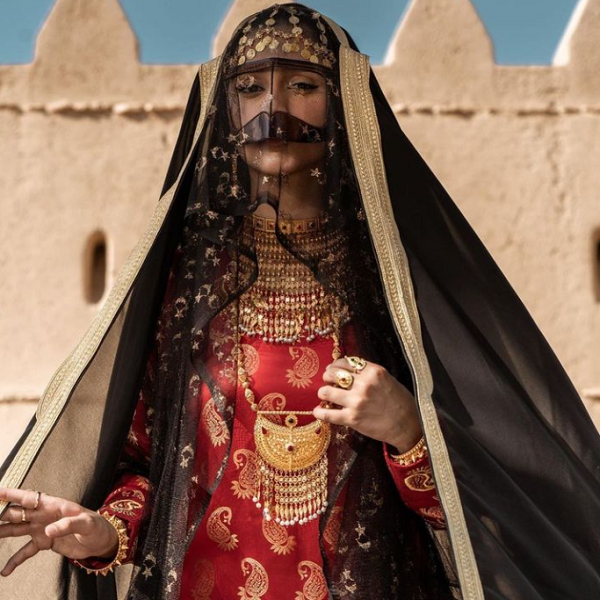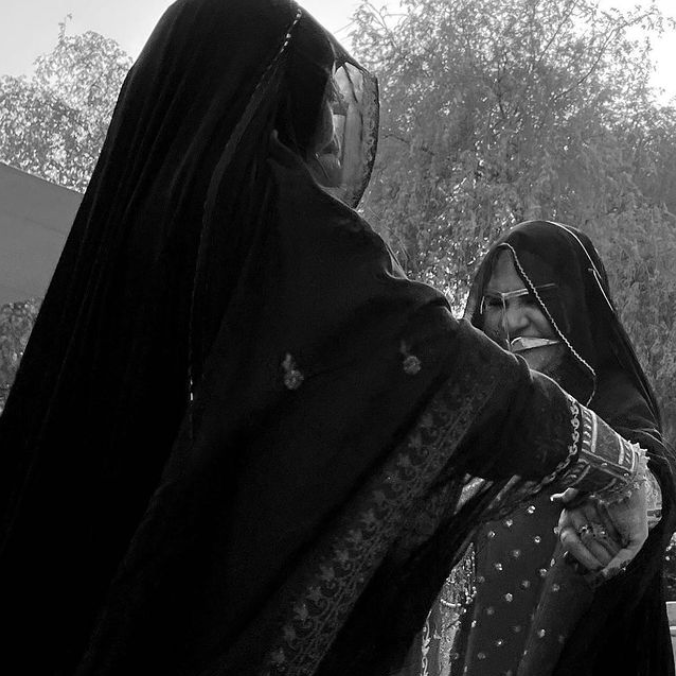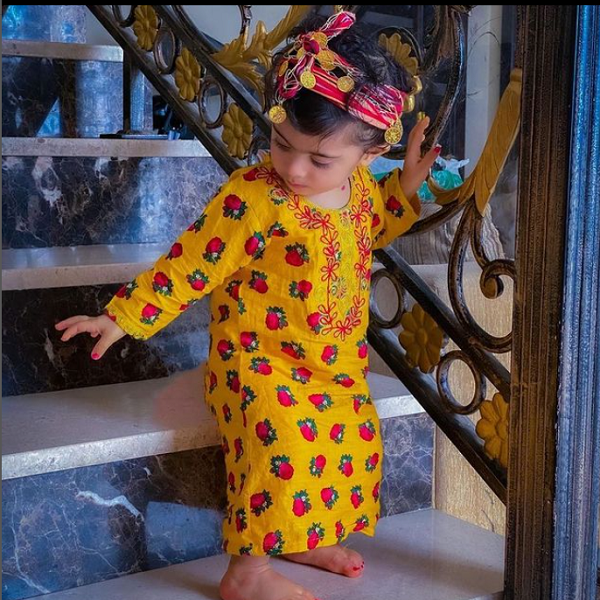This article is the second in a series based on Dr Reem el Mutwalli’s book
Sultani
Sulṭānī: (Arabic: sultān: king). In the UAE the term denotes to silk satin fabric in multiple vertical striped colours, commonly used for tunics (kanadir) and underpants (sarāwīl). Also refers to book: Sultani, Traditions Renewed, Changes in women’s traditional dress In the United Arab Emirates during the reign of the late Shaykh Zāyid Bin Sultan āl Nahyān, 1966-2004, By Dr. Reem Tariq
Ṭariq: (Arabic; Synonym: tulle_bi_talli
Tūlle_bi_tallī: (French: Tulle – a city in France where fine material for veil was first made; Turkish: tel – wire; Synonym: tariq; talli; badla; khus_dozi ), series of small metal knots made on a woven net ground as embellishment. The term is commonly used in the North African Arab region specifically in Egypt.
; talli; badla; khus_dozi ), series of small metal knots made on a woven net ground as embellishment. The term is commonly used in the Levant Arab region specifically in Lebanon.
El Mutwalli (2011).: Traditions Renewed. Changes in women’s traditional dress in the United Arab Emirates during the reign of the late Shaykh Zayid Bin Sultan Al Nahyan, 1966-2004, which, in turn, is based on her PhD thesis in Islamic Art and Archaeology obtained from SOAS, University of London, UK, in 2007. Inspired by The
Zay
Zay: (Arabic: costume, Pl. azyaā’), a set of clothes in a style typical of a particular country or historical period. Initiative’s exhibition called
Bū Tīlah wa Bū Glaym: Spots & Stripes at Zaman Awal in The Mall of the Emirates which focuses on examples of two forms of fabrics traditionally favoured in articles of UAE traditional dress. Here we give an overview of a wide range of fabrics and textiles traditionally used for women’s clothing in the UAE.
In this article, we focus on the use of colour in dress textiles in the UAE.

Colour and meaning
Colour in clothes are used across cultures and eras to indicate different meanings and values. Purple has been associated with royalty in Roman times; in India, widows wear white as a colour of mourning, while in the west, they usually wear black. Colours are often used in religious garments such as black and/or white for Christian nuns, and orange robes for Buddhist monks, while in Islam, green is associated with heaven. In the wider society, white is often associated with peace, khaki with the military, green with nature, and black with sombre or depressing situations.
An excellent example of the use of black for concealment, with bright colours underneath, and luxury fabrics and embellishments on the visible parts of the inner garment
Colour in the UAE
Bright and vibrant colours such as yellow, fuchsia, blue, green, and orange have lost their negative connotations from the past and are popular with women in the UAE. When it comes to traditional UAE dress, Emirati women are fascinated with colour and texture and use it liberally to contrast the rather uniform cut and design of their garments.
Economic constraints in the past forced women to use expensive or valuable fabrics, usually the more colourful pieces, sparingly, often only using it for the visible part of the garment, and often reusing and repurposing it from one garment to the next. Even though these constraints are not relevant today, the practice of using colour only for certain parts of a traditional garment has remained.
“M. Yamani maintains ‘only the Bedouins wear loud colours’, saying that traditionally, desert women from the heart of the Peninsula, wear brighter stronger colours, such as reds, yellows, and greens, with bigger patterns, while urban women from the western province wear muted greys, blues, greens, or beige decorated with smaller motifs. Most UAE women favour contrasting, vibrant colours, confirming the common Saudi view that UAE people are Bedouins.” P189-190 Sultani
Sulṭānī: (Arabic: sultān: king). In the UAE the term denotes to silk satin fabric in multiple vertical striped colours, commonly used for tunics (kanadir) and underpants (sarāwīl). Also refers to book: Sultani, Traditions Renewed, Changes in women’s traditional dress In the United Arab Emirates during the reign of the late Shaykh Zāyid Bin Sultan āl Nahyān, 1966-2004, By Dr. Reem Tariq
Ṭariq: (Arabic; Synonym: tulle_bi_talli
Tūlle_bi_tallī: (French: Tulle – a city in France where fine material for veil was first made; Turkish: tel – wire; Synonym: tariq; talli; badla; khus_dozi ), series of small metal knots made on a woven net ground as embellishment. The term is commonly used in the North African Arab region specifically in Egypt.
; talli; badla; khus_dozi ), series of small metal knots made on a woven net ground as embellishment. The term is commonly used in the Levant Arab region specifically in Lebanon.
El Mutwalli (2011). Book
A shop window display in Naif Souk, Dubai, showing white clothes for boys and darker clothes for girls. Image by author
Black and White clothes for men and women
In Islamic law, white is considered as most fitting for men’s dress. This must reflect a later pious preference as the Prophet (S.) was known to wear different coloured garments, including green, red, and black, white with its association of purity, brightness, and loyalty is the colour of the Hajj and the Muslim burial attire.
At times, black is the colour of mourning and retribution, particularly in the Shi’ite Islamic culture. It is also considered a powerful protection against the evil eye. This leads to a widely debated question of the reasons behind the preference for white clothes for men and black clothes for women. In the West, some negative feelings against Islam are influenced by the association of women’s black garments and veils with the subordination and submission of women in Muslim societies. The following points may help to clarify this issue:
Differentiation between the sexes
Islam, like other religions, condemns transvestism, and this prohibition in Islam refers to the overall demeanour as much as to dress. However, in earlier times, any items of traditional clothing were worn by both men and women. Therefore, colour was used to differentiate between the sexes. White garments of any kind, except the
sirwal
Sirwāl: (Farsi: shalvār; Synonym: Salwar, Ṣarwāl, sharwāl, salbāl, khalag), pair of trousers with tapering ankles and fastened with a draw string. Believed to have originated in Central Asia it has spread since in the Indian subcontinent between c. 1st – 3rd century BCE and the Middle East from c. 12th century. , were considered masculine and to be avoided by women, and thus they wore darker clothes.
A Bedouin family in a tribal setting
Tribal background
Black, dark green, or
indigo
Indigo: (Latin: Indigo – India, synonym: nil
Nīl: (Latin: indigo), Arabised term for Indigo, a natural dye belonging to the ‘Indigofera Tinctoria’ species of plants that have been cultivated in East Asia, Egypt, India, and Peru since antiquity. According to Pliny the Elder, it was named after India as it was the source of the dye.), a natural dye belonging to the ‘Indigofera Tinctoria’ species of plants that has been cultivated in East Asia, Egypt, India, and Peru since antiquity. According to Pliny the Elder, it was named after India as it was the source of the dye. blue were colours associated with modesty and dignity. Therefore, these colours were worn by women during Hajj and when in mourning. Athwâb in these colours were specifically tailored for use outdoors as such a garment was known as
thawb
Thawb: (Arabic: thawb, Pl. Athwāb/thībān), can be pronounced thobe
Thobe: (Arabic: thawb, Pl. Athwāb/thībān), can be pronounced thawb or tobe
Tobe: (Arabic: thawb, Pl. Athwāb/thībān), can be pronounced thawb or thobe based on locale. The standard Arabic word for ‘fabric’ or ‘garment’. It can refer to a qamīs-like tunic worn by men and women in the Arabian Peninsula, Iraq, the southern and south-western ports and islands of Iran, and some countries in East and West Africa. More specifically, it can refer to the square-shaped Bedouin overgarment worn by women. based on locale. The standard Arabic word for ‘fabric’ or ‘garment’. It can also refer to a qamīs-like tunic worn by men and women in the Arabian Peninsula, Iraq, the southern and south-western ports and islands of Iran, and some countries in East and West Africa. More specifically, it can refer to the square-shaped Bedouin overgarment worn by women. or tobe
Tobe: (Arabic: thawb, Pl. Athwāb/thībān), can be pronounced thawb or thobe based on locale. The standard Arabic word for ‘fabric’ or ‘garment’. It can refer to a qamīs-like tunic worn by men and women in the Arabian Peninsula, Iraq, the southern and south-western ports and islands of Iran, and some countries in East and West Africa. More specifically, it can refer to the square-shaped Bedouin overgarment worn by women. based on locale. The standard Arabic word for ‘fabric’ or ‘garment’. It can also refer to a qamīs-like tunic worn by men and women in the Arabian Peninsula, Iraq, the southern and south-western ports and islands of Iran, and some countries in East and West Africa. More specifically, it can refer to the square-shaped Bedouin overgarment worn by women in the Arabian Gulf region. -al-sūq. The older generation of UAE women mentioned that a black
thawb
Thawb: (Arabic: thawb, Pl. Athwāb/thībān), can be pronounced thobe
Thobe: (Arabic: thawb, Pl. Athwāb/thībān), can be pronounced thawb or tobe
Tobe: (Arabic: thawb, Pl. Athwāb/thībān), can be pronounced thawb or thobe based on locale. The standard Arabic word for ‘fabric’ or ‘garment’. It can refer to a qamīs-like tunic worn by men and women in the Arabian Peninsula, Iraq, the southern and south-western ports and islands of Iran, and some countries in East and West Africa. More specifically, it can refer to the square-shaped Bedouin overgarment worn by women. based on locale. The standard Arabic word for ‘fabric’ or ‘garment’. It can also refer to a qamīs-like tunic worn by men and women in the Arabian Peninsula, Iraq, the southern and south-western ports and islands of Iran, and some countries in East and West Africa. More specifically, it can refer to the square-shaped Bedouin overgarment worn by women. or tobe
Tobe: (Arabic: thawb, Pl. Athwāb/thībān), can be pronounced thawb or thobe based on locale. The standard Arabic word for ‘fabric’ or ‘garment’. It can refer to a qamīs-like tunic worn by men and women in the Arabian Peninsula, Iraq, the southern and south-western ports and islands of Iran, and some countries in East and West Africa. More specifically, it can refer to the square-shaped Bedouin overgarment worn by women. based on locale. The standard Arabic word for ‘fabric’ or ‘garment’. It can also refer to a qamīs-like tunic worn by men and women in the Arabian Peninsula, Iraq, the southern and south-western ports and islands of Iran, and some countries in East and West Africa. More specifically, it can refer to the square-shaped Bedouin overgarment worn by women in the Arabian Gulf region. was used by women outdoors in the old days and early photographic images confirm this quite clearly. The black
thawb
Thawb: (Arabic: thawb, Pl. Athwāb/thībān), can be pronounced thobe
Thobe: (Arabic: thawb, Pl. Athwāb/thībān), can be pronounced thawb or tobe
Tobe: (Arabic: thawb, Pl. Athwāb/thībān), can be pronounced thawb or thobe based on locale. The standard Arabic word for ‘fabric’ or ‘garment’. It can refer to a qamīs-like tunic worn by men and women in the Arabian Peninsula, Iraq, the southern and south-western ports and islands of Iran, and some countries in East and West Africa. More specifically, it can refer to the square-shaped Bedouin overgarment worn by women. based on locale. The standard Arabic word for ‘fabric’ or ‘garment’. It can also refer to a qamīs-like tunic worn by men and women in the Arabian Peninsula, Iraq, the southern and south-western ports and islands of Iran, and some countries in East and West Africa. More specifically, it can refer to the square-shaped Bedouin overgarment worn by women. or tobe
Tobe: (Arabic: thawb, Pl. Athwāb/thībān), can be pronounced thawb or thobe based on locale. The standard Arabic word for ‘fabric’ or ‘garment’. It can refer to a qamīs-like tunic worn by men and women in the Arabian Peninsula, Iraq, the southern and south-western ports and islands of Iran, and some countries in East and West Africa. More specifically, it can refer to the square-shaped Bedouin overgarment worn by women. based on locale. The standard Arabic word for ‘fabric’ or ‘garment’. It can also refer to a qamīs-like tunic worn by men and women in the Arabian Peninsula, Iraq, the southern and south-western ports and islands of Iran, and some countries in East and West Africa. More specifically, it can refer to the square-shaped Bedouin overgarment worn by women in the Arabian Gulf region. was commonly known to them as the Bedouin women's dress.

Ensuring maximum concealment
Black ensures maximum concealment of whatever is worn underneath, especially if the inner clothes have vibrant colours. Bedouin women mostly wore a black
thawb
Thawb: (Arabic: thawb, Pl. Athwāb/thībān), can be pronounced thobe
Thobe: (Arabic: thawb, Pl. Athwāb/thībān), can be pronounced thawb or tobe
Tobe: (Arabic: thawb, Pl. Athwāb/thībān), can be pronounced thawb or thobe based on locale. The standard Arabic word for ‘fabric’ or ‘garment’. It can refer to a qamīs-like tunic worn by men and women in the Arabian Peninsula, Iraq, the southern and south-western ports and islands of Iran, and some countries in East and West Africa. More specifically, it can refer to the square-shaped Bedouin overgarment worn by women. based on locale. The standard Arabic word for ‘fabric’ or ‘garment’. It can also refer to a qamīs-like tunic worn by men and women in the Arabian Peninsula, Iraq, the southern and south-western ports and islands of Iran, and some countries in East and West Africa. More specifically, it can refer to the square-shaped Bedouin overgarment worn by women. or tobe
Tobe: (Arabic: thawb, Pl. Athwāb/thībān), can be pronounced thawb or thobe based on locale. The standard Arabic word for ‘fabric’ or ‘garment’. It can refer to a qamīs-like tunic worn by men and women in the Arabian Peninsula, Iraq, the southern and south-western ports and islands of Iran, and some countries in East and West Africa. More specifically, it can refer to the square-shaped Bedouin overgarment worn by women. based on locale. The standard Arabic word for ‘fabric’ or ‘garment’. It can also refer to a qamīs-like tunic worn by men and women in the Arabian Peninsula, Iraq, the southern and south-western ports and islands of Iran, and some countries in East and West Africa. More specifically, it can refer to the square-shaped Bedouin overgarment worn by women in the Arabian Gulf region. as they were constantly moving in public areas and lived in less protective quarters such as tents. Those who lived in houses were protected and only wore black thawbs when they left their homes.
***
UAE women at Dubai Design Week in 2021. Showing the contemporary use of colour in traditional garments. Moving away from black abayas. Image by author
The previous articles in this series can be viewed here:
Textiles in UAE dressCotton and Silk in UAE dressEmbellished and European textiles in UAE dress
*all images from the
@sultanibookuae Instagram page unless otherwise stated. This page is managed by Dr Reem el Mutwalli and features images and stories of traditional UAE dress.






